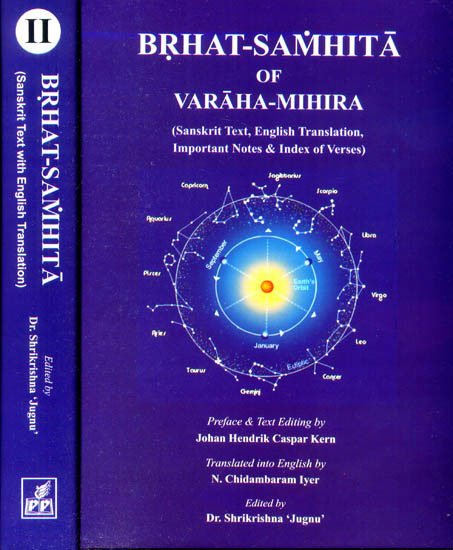Brihat Samhita
by N. Chidambaram Iyer | 1884 | 135,584 words | ISBN-13: 9788171104215
This page describes rain (pravarshana) which is the twenty-third Chapter of the English translation of the Brihat-samhita. This work, written by Varahamihira in the 6th century, is classified as jyotisha literature, also known as Indian astronomy. It contains however, also content regarding astrology, palmistry, agriculture, gardening, perfumes, medicines and various other encyclopedic topics.
Chapter 23 - On rain (pravarṣaṇa)
[Sanskrit text for this chapter is available]
1. Judging from the rain that falls on the days when the Moon passes from the asterism of Pūrvāṣāḍha to that of Mūla in the lunar month of Jyeṣṭha and after the full-moon, an astronomer should predict the agricultural condition of the country as well as the quantity of rainfall in the coming rainy season.
2. Falling rain should be collected in a vessel with a circular mouth, a cubit in diameter and the collected rain should be measured with a vessel whose capacity is an Āḍhaka, which is equal to 50 phalās.[1]
3. There will be continuous rain for as many days of the Moon’s course from Pūrvāṣāḍha onwards (in the rainy season) as the number of asterisms, through which, when the Moon passes, a shower of rain occurs just marking the Barth, from the same asterism of Pūrvāṣāḍha in the lunar month of Jyeṣṭha, or there will be rain for as many days as the number of rain drops sticking to the edge of the blades of grass. The quantity of subsequent rainfall can also be ascertained from such rain.[2]
4. Some writers say that the subsequent rainfall will be confined to the spot where the first shower falls; others say that the extent of the subsequent rainfall will be 10 yojanas all round; but according to Garga, Parāśara and Vasiṣṭha, the extent is 12 yojanas.
5. If there should be rain when the Moon passes through certain asterisms from Pūrvāṣāḍha to Mūla in the lunar month of Jyeṣṭha, then there will also be rain when the Moon passes through the same asterism in the rainy season. If there should be no rain in the month of Jyeṣṭha, there will be no rain in the rainy season.
6. If there should be a fall of rain when the Moon passes through the asterisms of Hasta, Pūrvāṣāḍha, Mārgaśīrṣa, Citrā, Revatī and Dhaniṣṭhā in the month of Jyeṣṭha, there will fall 16 droṇas of rain in the coming rainy season. If there should be a fall when the Moon passes through Śatabhiṣaj, Jyeṣṭhā and Svāti, in the month of Jyeṣṭha, the subsequent rainfall will be 4 droṇas. If there should be a fall when the Moon passes through Kṛittikā, the quantity of subsequent rainfall will be 10 droṇas.
7. If there should be a fall of rain when the Moon passes through Śravaṇa, Maghā, Anurādhā, Bharaṇī and Mūla, the quantity of subsequent rainfall will be 14 droṇas. If when through Pūrvaphālguni, the quantity will be 25 droṇas; if when through Punarvasu, the quantity will be 20 droṇas.
8. If there should be a fall of rain when the Moon passes through the asterisms of Viśākhā and Uttarāṣāḍha in the lunar month of Jyeṣṭha, the quantity of subsequent rainfall will be 20 droṇas; if when through Āśleṣā, the quantity will be 13 droṇas; if when through Uttarabhādrapada, Uttaraphālguni and Rohiṇī, the quantity will be 25 droṇas.
9. If there should be a fall of rain when the Moon passes through the asterisms of Pūrvabhādrapada and Puṣya in the lunar month of Jyeṣṭha, the quantity of rainfall in the coming winter will be 15 droṇas; if when through Aśvinī, the quantity will be 12 droṇas; if when through Ārdrā, it will be 18 droṇas. In all the above cases, the subsequent rainfall depends upon the asterisms remaining unaffected by comets, meteors and the like from the month of Jyeṣṭha to the rainy season.
10. If the asterisms should suffer by the meeting together in them of the Sun, Saturn and Ketu (descending node of the Moon) or by the course of Mars through them or by meteoric falls, comets or planetary conjunctions, there will be neither rain nor prosperity in the land; but if benefic planets should pass through the asterisms or if the asterisms should remain unaffected in any of the ways described above, mankind will be happy.
Footnotes and references:
[1]:
Parāśara defines an Āḍhaka to be the capacity of a vessel with a circular mouth, 20 inches in diameter and whose depth is 8 inches.
[2]:
If such first shower should be excessive there will be no rain in the rainy season.
